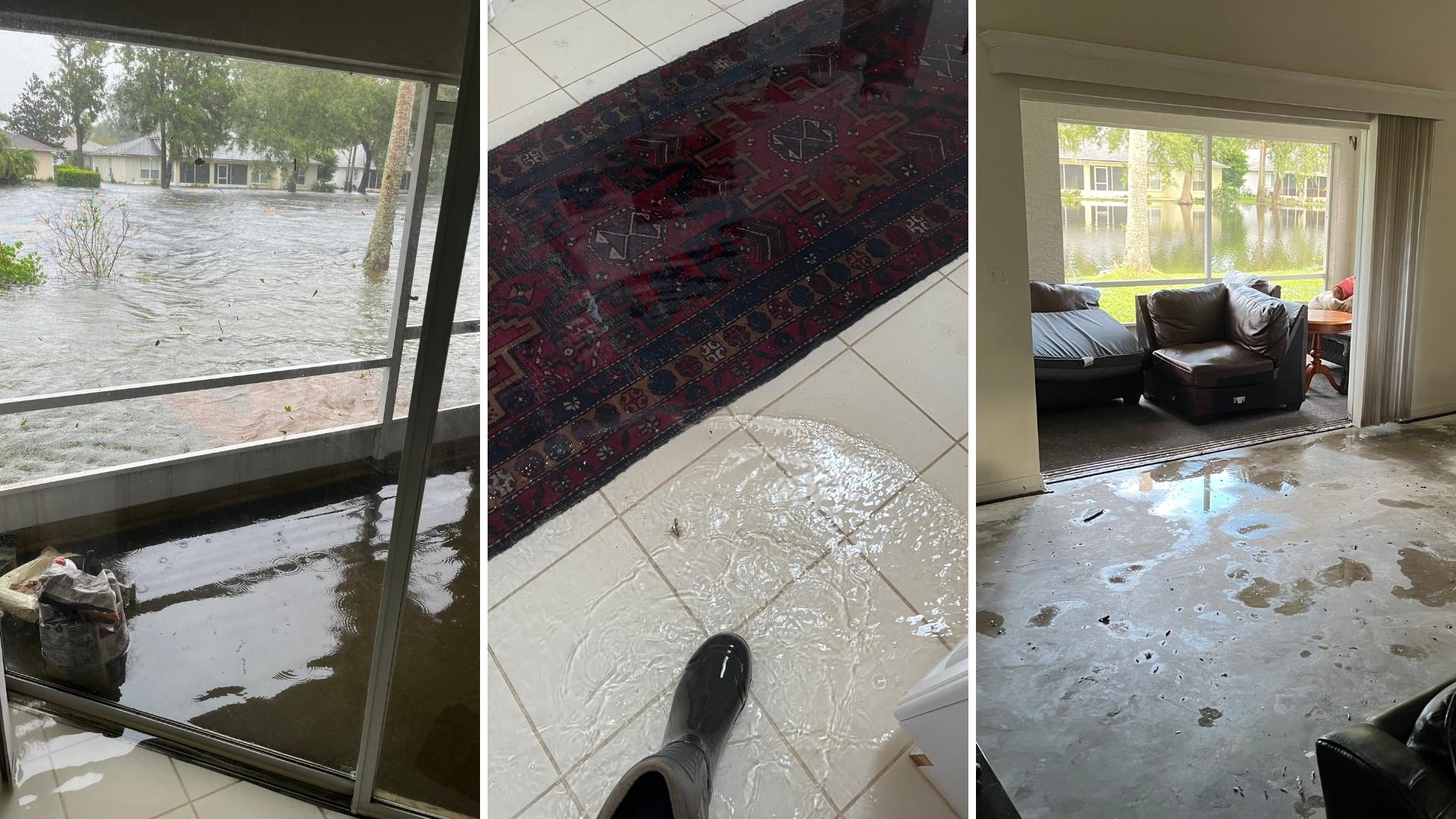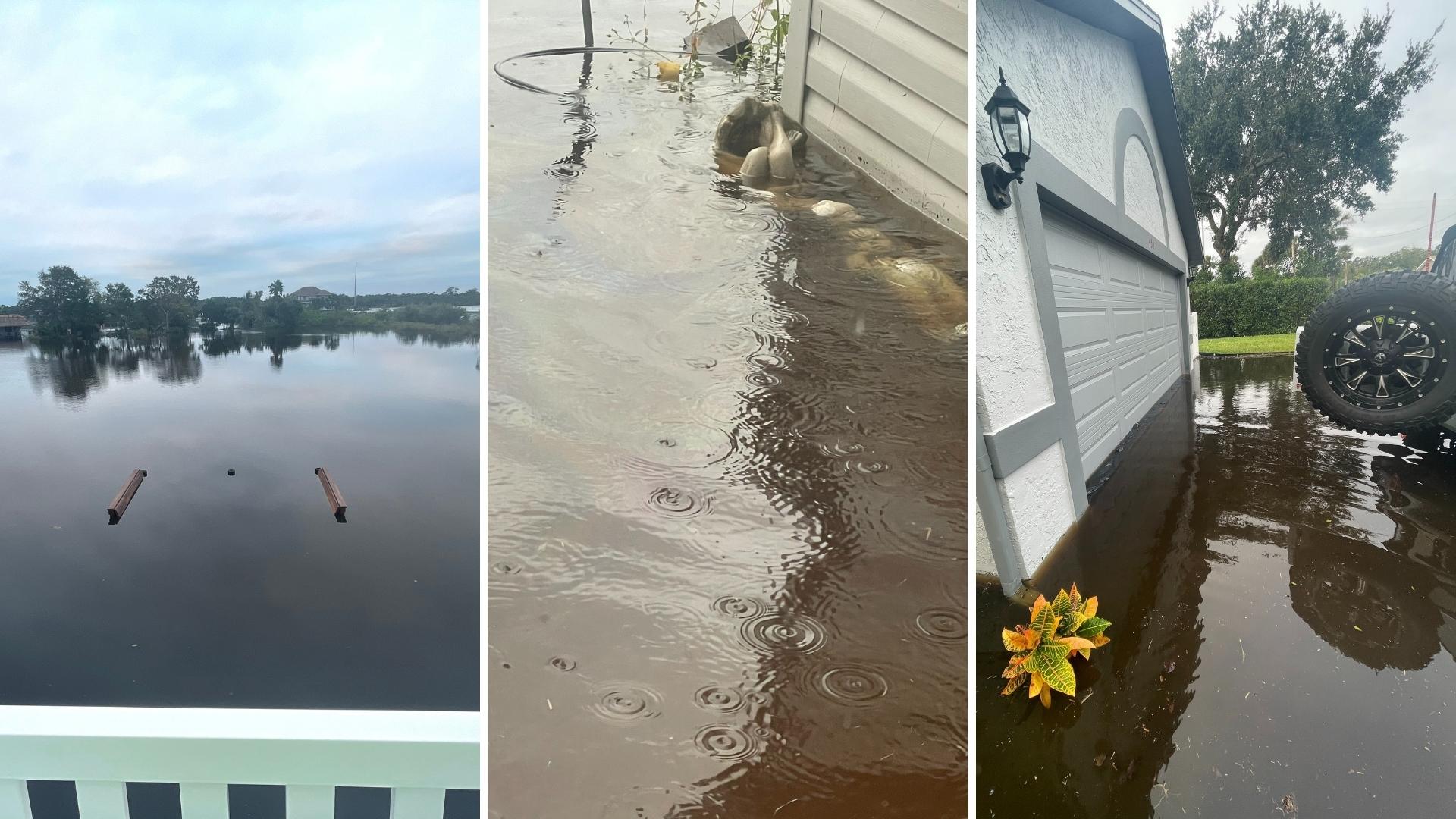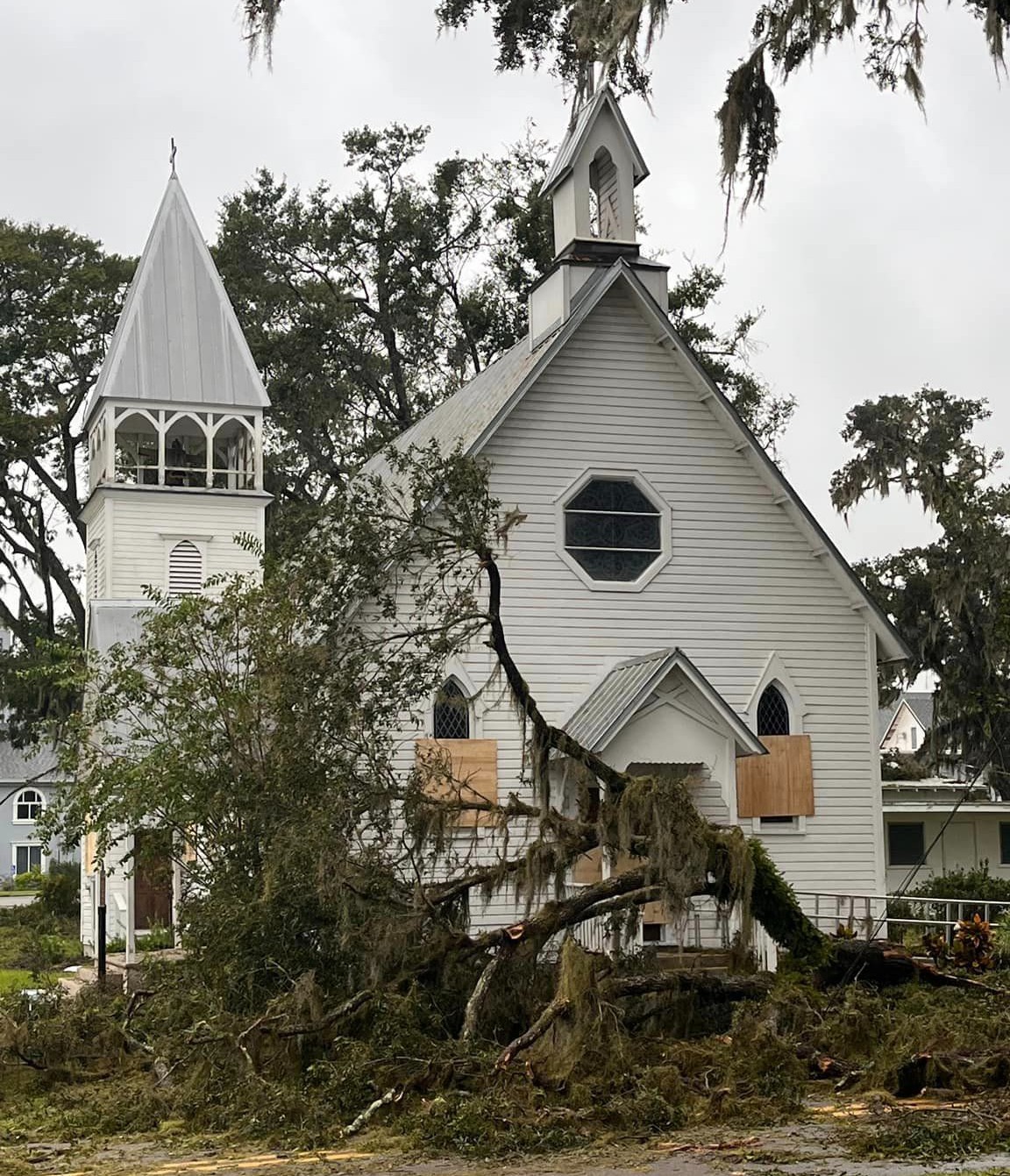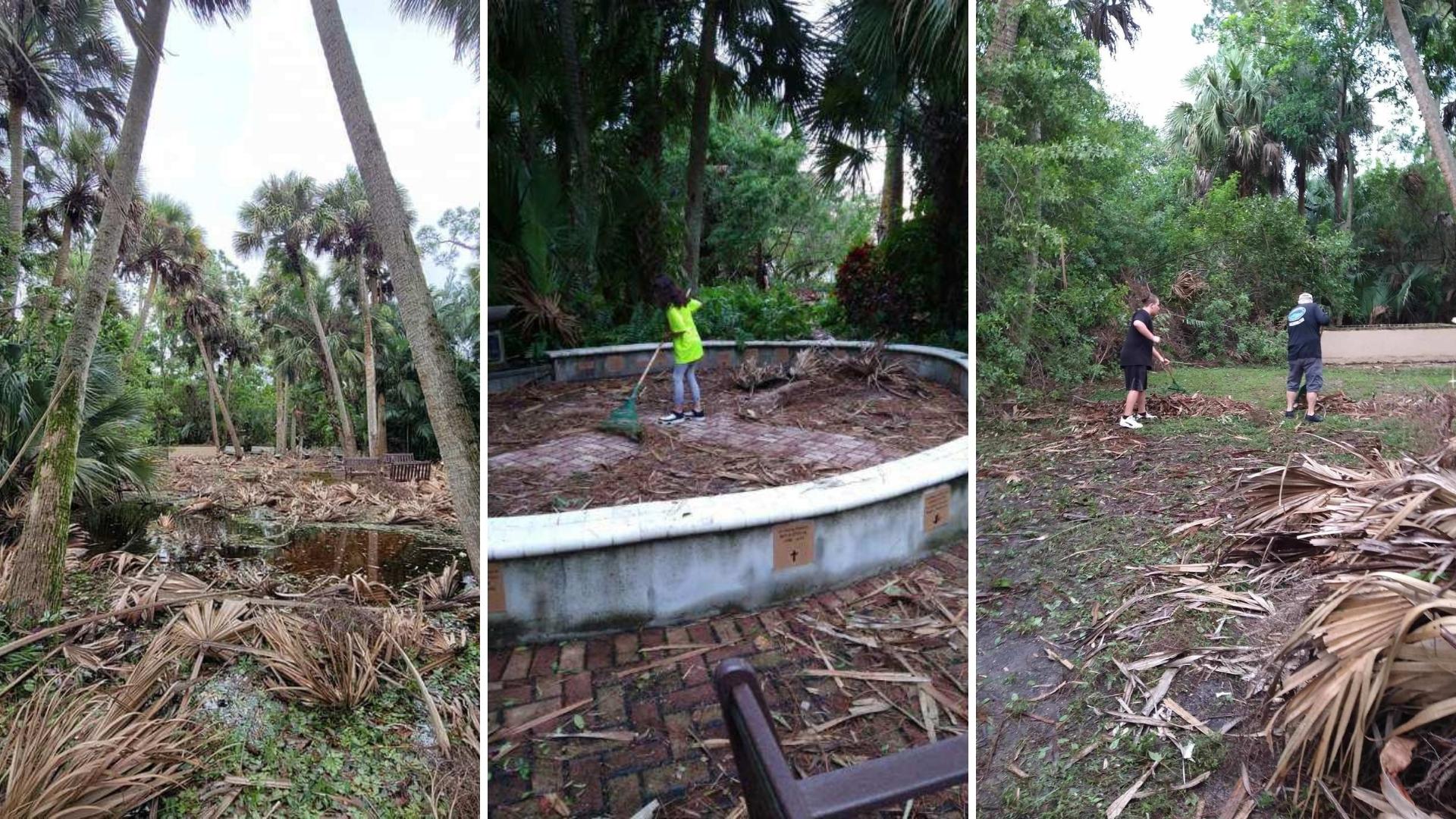In a neighborhood safely out of a flood zone, The Rev. Jason Murbarger, rector of St. Mary’s, Daytona Beach, looked out of his window mid-day on Thursday, Sept. 29, to check on his property in the onslaught of Hurricane Ian. Water extended halfway over the sidewalk in front of the house, and since it was already high tide, he thought, “This is great. The worst is behind us.”

Flooding and cleanup at the Murbargers’ residence in Daytona Beach | Photos: The Rev. Jason Murbarger
He and his wife, Sharon, took a short nap. When they woke up, their carpet was floating.
Within 12 hours, the water in the Murbargers’ home had receded, although water on their street remained at a three-foot depth. “On Friday [Sept. 30], we ripped up carpets and sliced up our Oriental rugs,” Murbarger said.
Dehumidifiers have been running ever since, now more than two weeks since the storm. “The floors will need to be replaced, but we’ll be fine,” he said. And Murbarger has another reason to rejoice: Ian did no significant damage to St. Mary’s.
Direct Hit
Just 24 hours earlier, The Very Rev. Roy Allison was at work at St. James, Ormond Beach, when he received news that an unexpected shift in the storm would create a direct hit on Daytona Beach. While Ian battered Southwest Florida, Allison left the church early and joined long lines of Volusia County residents to get his 10 county-allotted free sandbags. “Everyone was in good moods, helping each other fill their bags and joking around,” he said. Still in his clericals (garb worn by clergy members), he dropped off the sandbags at home and went to buy 30 more.

Floodwaters surrounding the Allisons’ house, covering the dock and rising above sandbags | Photos: The Very Rev. Roy Allison
A short time later, he and his family – his wife, The Rev. Marcia Allison; and his mother, who had evacuated to their home from St. Petersburg – waited for Ian. Their doors were sealed, the sandbags were in place and they felt prepared.
Living on an inlet of the Tamoka River, Allison felt certain the water would rise over the seawall, but that level turned out to be just the beginning. Soon the bench on the dock was covered, indicating a four-foot rise. Then the wind shifted, and water moved toward the house.
“The sandbags actually did their jobs, and water didn’t come in through the doors,” he said. “I didn’t even know there was water in the house until I walked into my study and realized the carpet was wet. It was coming up from the foundation.”
Allison got his mother upstairs, and he and Deacon Marcia began moving as much as they could to the second floor. A short time later, Allison saw whitecaps in his backyard. “That meant there were two-foot waves at the back of the house, so Marcia and I went upstairs to wait it out,” he said.

A large limb narrowly misses the 136-year-old sanctuary at Christ Church, Fort Meade. Minor water damage in the bell tower was quickly repaired. | Photo: Facebook
The next day, the water had not receded, and the rain was still coming down, but the trio was able to wade through the knee-deep water on the first floor and into the driveway where Allison’s lifted Jeep was parked, the water reaching the bottom of the doors. Comfortable navigating the familiar but deeply flooded road, Allison drove them safely out of the neighborhood, where they reached dry land. A parishioner has graciously offered them a condominium, where they will live until their home is repaired.
Repairs have already started in the Allisons’ home. Baseboard and drywall replacement is underway, and parishioners loaned the couple an air purifying machine. As with the Murbargers’ church, St. James had no noteworthy impact from the storm.
“I’ve never experienced anything like this, but it’s been really great to see the community come together,” Allison said. “There are still so many people who need our prayers and support.”
Preventive Maintenance
Fifty miles south, The Rev. Rob Griffith left home early Thursday morning during a break between storm bands to check on his church, the historic St. Gabriel’s, Titusville. He was expecting water intrusion in the parish hall as the roof is due for replacement, a project that has been funded and contracted but not yet scheduled. He was grateful to find only minor water damage in the nave from a leak in the belfry and about an inch of water in the sacristy, which he mopped up right away.
But his greatest sigh of relief came months earlier when the vestry agreed to have a large, diseased oak tree removed from the property. One limb in particular teetered precariously over the parish hall. “If we hadn’t had that tree removed in May, it could have taken out the whole building,” he said. “This is why regular maintenance is so important.”
Boy Scout Troop 370, led by Matt Mills, went to the church the following Saturday to pick up palm fronds and a few small branches in the yard. “They did an outstanding job, and I am so thankful for their willingness to help,” Griffith said.
Two months ago, Christ Church, Longwood, launched “God at Work,” a capital campaign to raise the funds for a roof replacement on one of its buildings. Hurricane Ian exacerbated the need for a roof, but the deductible is higher than the amount raised to date.
“I’ve had a number of sleepless nights over this claim,” said The Rev. Michelle Roach, rector. “I’m going to God in prayer because he knows our needs before we do.”
The capital campaign continues while the church awaits news from the insurance claim. The church also lost a number of trees on the property and had significant lawn debris, which a team of dedicated parishioners worked to clear. “We are small, but mighty,” Roach said.
Extended Impact
Though substantial physical cleanup was not required of The Rev. Gary Jackson, rector of Grace, Port Orange, consistent spiritual and emotional support to his parishioners was needed. “We had eight households who had either partial or total loss of their homes and belongings,” he explained. “A lot of people don’t know that Volusia County was one of the hardest-hit counties outside of Southwest Florida.”
But The Rev. Jim Giles knows. As the executive director for Gateway to Hope, a mobile food pantry based in Ocala, he explained that numerous Volusia County residents have been driving over 70 miles to receive nonperishable food from Gateway to Hope’s five locations in Marion County as well as hot meals they provide on Thursdays. To better serve Volusia County, he has partnered with two churches in New Smyrna Beach to offer popup Gateway to Hope locations.
Holy Trinity, Bartow, in Polk County, is working to support its local food and clothing bank, which flooded a few weeks before Hurricane Ian. “Not only are they trying to feed people from Ian, but they’re trying to do that in a makeshift facility with fewer resources,” said The Rev. Becky Toalster, rector. “Holy Trinity is collecting items to try to bridge that gap for them, and there has been a great response so far.”
Continuing Assistance
“Overall, the churches in our diocese fared well and sustained minor damage,” said The Rev. Canon Scott Holcombe, canon to the ordinary. “Bishop Brewer has been in touch with the bishop of the Diocese of Southwest Florida and will be coordinating our support, which will likely continue for several months. Their needs are extensive, and we want to be available to help them generously.
“This is also a great time for churches and individuals to make thorough disaster plans,” Holcombe urged. “Hurricane season is not over yet.”
Immediate diocesan needs should also prompt our prayers and gifts. Episcopal Relief & Development provides one emergency ministry relief grant per diocese, but these grants may not be used for hurricane damage to buildings. After completing a thorough needs analysis and report of damage throughout the diocese, Holcombe focused his efforts on applying for a $15,000 grant that was subsequently approved. Once the funds are received, the money will provide financial assistance to the food pantries in the diocese that need crisis support following the storm.

Nativity, Port St. Lucie, experienced substantial flooding in the Memorial Garden. A group of 30 people worked to clear the property of debris in time for their Blessing of the Animals, filling 12 truckloads.” Photos: The Rev. Tracy Dugger
Holcombe has also asked the dean of each deanery to gather extra hurricane supplies that parishioners and churches are no longer using. The Rev. John Motis, deacon at Church of the Good Shepherd, Lake Wales and diocesan disaster relief coordinator, will pick up the items and distribute them to food pantries throughout the diocese.
Holcombe explained that on top of the Episcopal Relief & Development grant, an additional $25,000 is needed to adequately assist these vital ministries. “Bishop Brewer and I are committed to helping raise this much-needed money to assist our feeding programs,” he said.
To support this effort, interested churches and individuals should send their donations as soon as possible to the diocesan office at 1017 E. Robinson Street, Orlando, FL 32801. Make checks payable to “The Bishop’s Discretionary Fund,” and put “FOOD” in the memo line. For online giving, please visit this link, select “Bp Discretionary-Pantries” and type “FOOD” in the memo field.



